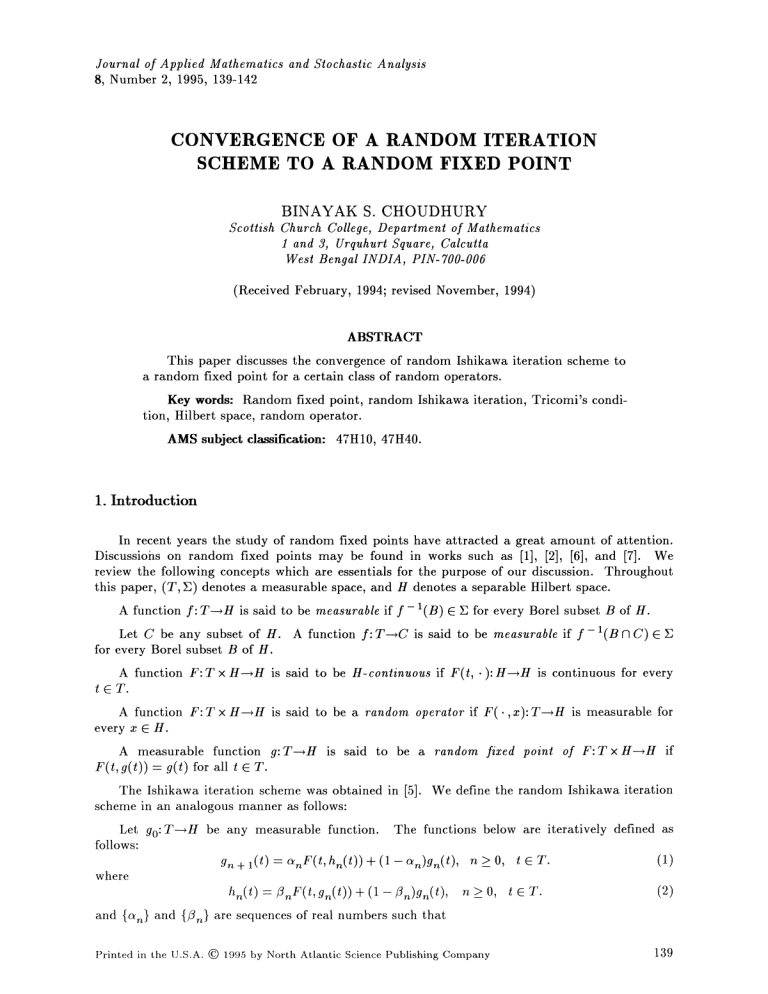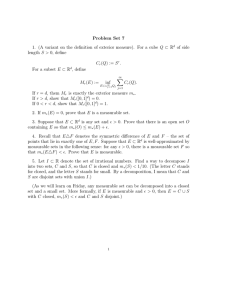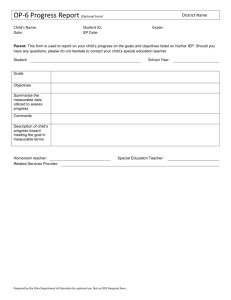A FIXED CONVERGENCE OF RANDOM ITERATION
advertisement

Journal of Applied Mathematics and Stochastic Analysis
8, Number 2, 1995, 139-142
CONVERGENCE OF A RANDOM ITERATION
SCHEME TO A RANDOM FIXED POINT
BINAYAK S. CHOUDHURY
Scottish Church College, Department of Mathematics
1 and 3, Urquhurt Square, Calcutta
West Bengal INDIA, PIN-700-O05
(Received February, 1994;
revised November,
1994)
ABSTRACT
This paper discusses the convergence of random Ishikawa iteration scheme to
point for a certain class of random operators.
a random fixed
Key words: Random fixed point, random Ishikawa iteration, Tricomi’s condition, Hilbert space, random operator.
AMS subject classification: 47H10, 47H40.
1. Introduction
In recent years the study of random fixed points have attracted a great amount of attention.
Discussiofis on random fixed points may be found in works such as [1], [2], [6], and [7]. We
review the following concepts which are essentials for the purpose of our discussion. Throughout
this paper, (T, E) denotes a measurable space, and H denotes a separable Hilbert space.
A function f: T--H is said to be measurable if f- I(B) E E for every Borel subset B of H.
Let C be any subset of H. A function f:T--+C is said to be measurable iff-I(BC) EE
for every Borel subset B of H.
A function F:T x H--,H is said to be H-continuous if F(t,. ): H---+H is continuous for every
tET.
A
function F: T x H---H is said to be a random operator if
every x 6 H.
A measurable function g:T--,H is said to be
t T.
a random
F(. ,x): T--H
is measurable for
fixed point of F:TxH--H
if
F(t, g(t)): g(t) for all
The Ishikawa iteration scheme was obtained in
scheme in an analogous manner as follows:
Let go’T--H be any measurable function.
[5]. We
define the random Ishikawa iteration
The functions below are iteratively defined as
follows:
gn + 1(t)
where
hn(t
and
{c,}
and
{/n}
Printed in the U.S.A.
cnF(t, hn(t)) + (1 n)gn(t),
nF(t, gn(t))+ (1-/n)gn(t),
n
n
>_ O,
_> 0,
T.
E T.
(1)
(2)
are sequences of real numbers such that
(C)
1995 by North Atlantic Science Publishing
Company
139
BINAYAK S. CHOUDHURY
140
0
< c,/3, < 1 for all
n
>_ 0
(3)
M<1
lim sup/ n
(4)
and
n--1
Let C C H, k: C-C is said to satisfy Tricomi’s condition in C if p E C and k(p)
I k(x)- P ll <- I x- P ll
I
+(1 A)y- z I
(6)
for allxeC.
[5]:
therefore for any x, y, z H and any real
I z I 2 +(1 A)II u- z 11 - A(1 A)II
The following lemma was proved in
Lemma: H is a Hilbert space;
p imply
,
y
I2
2. Main Result
Theorem 1: Let H be a separable Hilbert space. F:T x H--H is an H-continuous random
operator in which case there exists f: T--H (not necessarily measurable) such that
I[ F(t,x)- f(t) I
for
<-
]] x- f(t) I
(8)
all t G T and x G H.
Then, for any measurable function go:T--H, the sequence of functions {gn} defined by the
random Ishikawa iteration scheme, if convergent, converges to a random fixed point of F.
Proof: For any t G T,
Ilgn+l(t)-f(t)ll 2
I[ cnF(t, hn(t)) + (1 Cn)gn(t
f(t) I 2
cn I F(t, hn(t))- f(t)[I 2 + (1 -an)II gn(t) f(t)II 2
-an(1 -an)11 F(t, hn(t))- gn(t) I 2 (by (7))
<- an I F(t, hn(t))- f(t) I 2 + (1 -an)I1 gn(t) f(t) I 2 (by (3))
<- an I hn(t) f(t) I 2 + (1 cn) I gn(t) f(t) I 2 (by (8))
<- I gn(t) f(t) I 2 --anOn(1 --/n) I F(t, gn(t))- gn(t) I 2
(by using (2), (7)and (8)).
It further implies that
N
E c-n(1
n)11 F(t, gn(t))- gn(t)II 2
n--’O
<- Il go( )- f(t)112- Il gN + l( t)-f(t)ll2
go(t) f(t) I 2 < c.
(9)
Convergence of a Random Iterative Scheme to
m
a
Random Fixed Point
For M’ satisfying M < M’ < 1, there exists a positive integer m 0 such that
_> m0 (by (4)). Therefore, 1-/m > 1- M’> 0 for all m > m0, or
m
(9)
and
(10)
E
m0
mm( 1 m) >- (1 M’)
m
E
m
c’/?m
/m < M’
141
for all
x)
(10)
0
imply,
nlirn inf I F(t,
a (t)II
0 for all t
T.
(11)
Hence, if {gn(t)} converges, for example to g(t), F(t, gn(t)) also converges to g(t).
Since F:TxH-*H is an H-continuous random operator and H is separable, {gn} is a
sequence of measurable functions [4] Therefore g lim g is measurable. Furthermore, F is Hcontinuous; thus, for all t E T,
t g t
g( t =lizng(t
=lkrnF
F(thlkrngn(t))- F(t, g(t)).
g is a random fixed point of F.
Hence,
Therefore, {gn} (if convergent) converges to a random fixed point of F.
Theorem 2: Let C C H be a convex and compact subset and F: T x C-*C satisfies
F is H-continuous;
a)
there exists f’T-*C such that IIF(t,x)-f(t)ll <- IIx-f(t) ll for all t E T and x
b)
C;
and
r(t, ). C-*C satisfies Tricomi’s condition in C for every t T.
Then, for any measurable function go’T-*C, the sequence {gn} of measurable functions
structed by the random Ishikawa iteration scheme converges to a random fixed point of F.
c)
con-
Proof: Since C is convex and compact, H is a separable Hilbert space and F is an Hcontinuous random operator and {gn} is a sequence of measurable functions from C to C.
Proceeding exactly as in Theorem 1, we obtain (as in (11))
nlirninf I F(t, gn(t)) gn(t) I O.
Therefore, for fixed t T, there exists {gni(t)} C {gn(t)} such that
,lirn I F(t, gni(t))- gni(t)II 0.
Since C is compact, there exists {gn (t)C {gni(t)}, such that {gn, (t)) is convergent.
k
k
(12)
Let
lim gn
x
k
From
(12)
and
(13), and since
lim
(x
F(t, 9n. (t))- 9(t),
k
F(t,g(t))- g(t) (since F
Hence, for fixed t
For any fixed
I
(13)
{gn, k (t)} C {gni(t)), we have
k
or
(t)- g(t).
k
is
H-continuous).
T, g(t)is a fixed point of F(t,. ).
E T,
2
]l znF(t, hn(t)) + (1 -n)g,(t)- g(t)[[2
+ 1(t) g(t)II
I F(t, h,(t))- g(t)II 2 + (1 c)]] gn(t) g(t)II 2
(14)
BINAYAK S. CHOUDHURY
142
an( 1 cn)II F(t, hn(t)) gn(t)II 2 (by (7))
hn(t) g(t)II 2 + (1 cn)II gn(t) g(t)II 2 (by (3) and Tricomi’s condition (6))
an I F(t,g(t))+ (1- )gn(t)-g(t)1 + (1 -a)II g(t)-g(t)II
an(n I F(t,g(t))- g(t)II + (1 )II gn(t)- g(t)II
(1 )II f(t, gn(t)) gn(t)II ) + (1 an)II gu(t) g(t)II 2 (by (7))
n(n I] g(t)- g(t)]] + (1- n)II gn( t)- g(t)II )
+(1 -n)II 9n(t) 9(t)I] (by (a) and Tricomi’s condition (6))
I] gn(t) g(t)I[ 2 + (1 )]1 g(t) g(t)]] 2
I (t)- (t)II
"
Therefore, for t E T,
<-- I gn(t) g(t) I1"
Since
{gn,k(t)}--g(t),. given e > 0, there exists n ikO such that
I gn + 1(t)
g(t) [I
I g.k
(t)- g(t) I <
(15)
.
0
By virtue of (15),
I gn(t)--g(t)II
Therefore, for t
T,2irng(t
< for all n > n
g(t). Since {gn’}
k0
is a sequence of measurable functions, g is also
measurable. Thus, g: T---C is a random fixed point of F: T
C-C.
Acknowledgement
I acknowledge the kind help extended to me by Professor J.N. Das, Department of Applied
Mathematics, University of Calcutta, during the preparation of this paper.
References
[1]
[2]
[]
[4]
[]
[6]
[7]
Beg, I. and Shahzad, N., Random fixed points and approximations in random convex
metric spaces, J. Appl. Math. Stoch. Anal. 6:3 (1993), 237-246.
Bharucha-Reid, A.T., Fixed point theorems in probabilistic analysis, Bull. A mer. Math.
Soc. 82 (1976), 641-657.
Cohn, D.L., Measure Theory, Birkhauser, Boston 1980.
Himmelberg, C.J., Measurable relations, Fund. Math. LXXXVII (1975), 53-71.
Ishikawa, S., Fixed points by a new iteration method, Proc. Amer. Math. Soc. 44 (1974),
147-150.
Itoh, S., Random fixed point theorems with an application to random differential
equations in Banach spaces, J. Math. Anal. Appl. 67 (1979), 261-273.
Sehgal, V.M. and Waters, C., Some random fixed point theorems for condensing operators,
Proc. A mer. Math. Soc. 90 (1984), 425-429.






